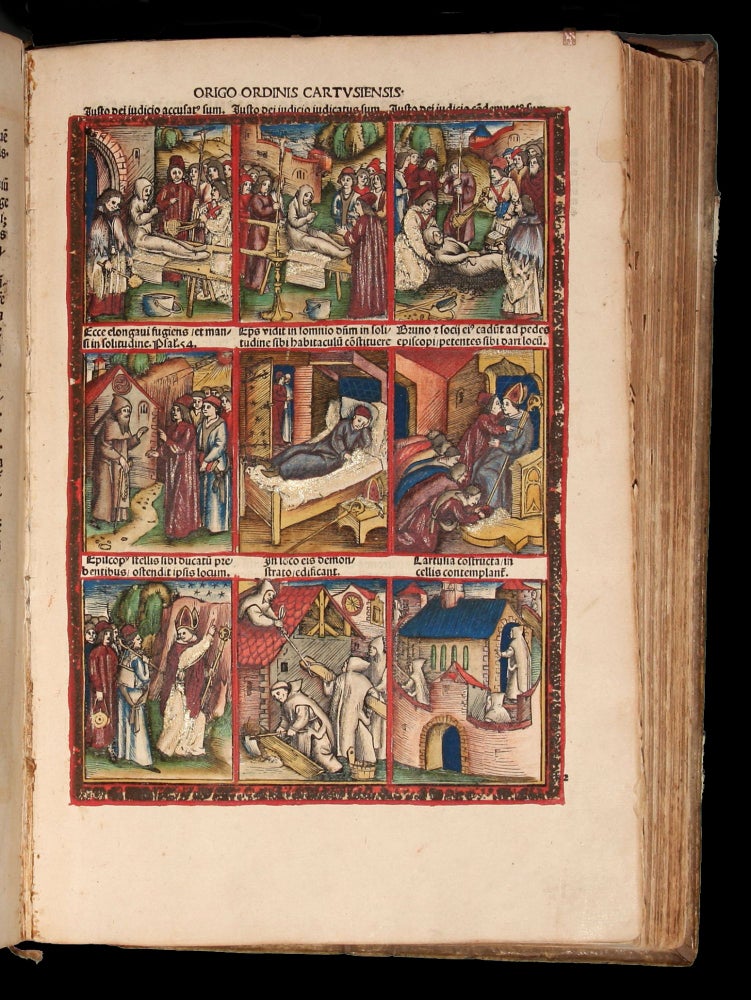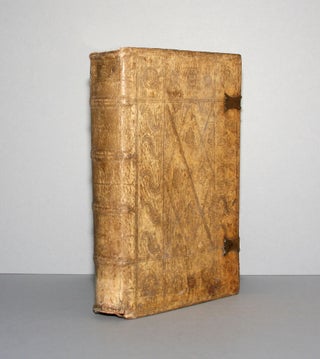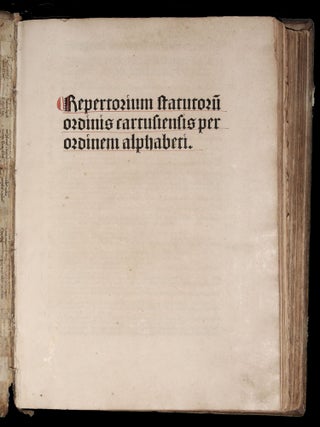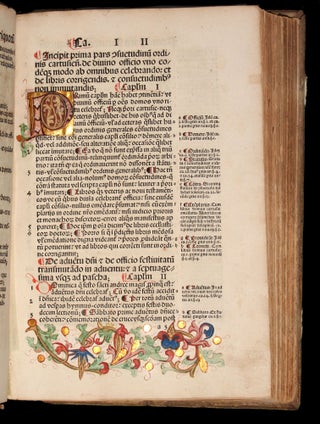Statua ordinis cartusiensis.
Folio [31.5 x 21.1 cm], (262) ff., 50 ff., with (5) ff. contemporary manuscript on paper (see below), and with (5) large woodcut illustrations and (33) smaller woodcut illustrations (all in contemporary hand-color), woodcut initials, illuminated initials and foliate borders in lower margin of four divisional titles, red initials throughout (a few with fine pen-work), rubrication throughout. Bound in contemporary blindstamped pigskin over wood boards, brass catches and clasp mounts (clasps lacking), reference tabs, front pastedown from 13th-century vellum manuscript (see below), text transfer from removed rear pastedown still visible. Some wear to extremities of spine, some rubbing, handsoiling and edge wear to spine and boards. Occasional minor marginal dampstaining, several manuscript annotations in text, minor color transfer to a few leaves facing illustrations, a few minor marginal repairs, a few minor marginal losses, a few repairs to inner margin (with loss of a few words at final leaf of Tertia compilatio).
Rare illustrated first edition (1510) of the Statua ordinis cartusiensis, “an exceptional case of a limited printing not available for public sale” (Elie, p. 38), here in an example with its fine woodcuts in excellent contemporary hand-color. These collected statutes and privileges of the Carthusian Order – part of the larger intellectual project of regularizing and disseminating monastic rules that was much en vogue around the year 1500 – are the result of a remarkable collaboration between the jurist François Dupuy (1450-1521), prior of the Grande Chartreuse, the renowned scholar Gregor Reisch (1467-1525), humanist and author of the famed Margarita philosophica (1503), the Swiss artist Urs Graf (ca. 1485-1528), and the renowned Basel printer Johann Amerbach (c. 1440-1513). Preserved in its contemporary binding, rubricated throughout, and with several fully illuminated initials and foliate borders, the present volume is supplemented with five leaves of manuscript text updating the work through the year 1522. The volume’s colophon (fols. 48v-49r) explicitly states that the work was to be owned only by members of the Order, and the edition rarely entered the book trade before modern times, with free circulation of the copies actively discouraged or even suppressed, leading early collectors to marvel at its rarity (e.g., “Livre extremement rare, et que les Chartreux suppriment autant qu’il peuvent” [Lenglet du Fresnoy]; see, Elie, pp. 44-9). Judging by the work’s (very interesting) register of 192 Carthsusian houses active at the time of printing (fols. 49r-5-r), it has been surmised that no more than 300 copies were produced (Elie, p. 39).
The volume’s numerous woodcuts (with the exception of one) are early works by Urs Graf, the goldsmith and printmaker who served for a time as a mercenary and is best remembered today for (in addition to his lively biography) his drawings of Reisläufer and Landsknechte mercenaries and for his book illustration and single-sheet woodcuts of varied subject matter. Large woodcuts in the Statua ordinis cartusiensis – several likely inspired by fresco paintings at Basel’s Carthusian house – include the founding of the Carthusian Order in nine scenes, the Carthusian “Tree of Succession” showing the Order’s ten most renowned leaders sprouting from the bosom of its founder, St. Bruno (d. 1101), a depiction of Prior General Guillaume Raynaud (d. 1402) reading from an open book while delivering new laws to fellow Carthusians, and a portrait of François Dupuy addressing his brothers (the final cut attributed to the ‘Master DS’). The “Tree of Succession” is repeated toward the end of the volume but with a border composed of 17 small woodcut portraits of various popes. Thirty-three woodcut portraits of Popes (with some repetitions) head the text of papal bulls pertaining to the Carthusians (see Muther, pp. 195-196, and Elie, pp. 50-8). All woodcuts are richly colored, the larger examples with highlights in silver.
The text of the Statua ordinis cartusiensis consists of the Carthusian’s original code (the Consuetudines) compiled by Guigo de Castro (1083-1137), fifth prior of the Grande Chartreuse, and later additions to and refinements of this code in the form of the Statuta antiqua (1259), the Statuta nova (1368) and the Tertia Compilatio as newly promulgated in 1509 by François Dupuy, prior of the Grande Chartreuse at the time of the volume’s printing. The present example preserves all 6 parts of the work, including the rare Privilegia Ordinis Cartusiensis, which, from an early date, the monks often removed for reference purposes (on the high rate of incomplete copies, including numerous instances of missing woodcuts, see Elie, pp. 42-1). The volume, printed at the expense of the Gregor Reisch’s Carthusian monastery of St. John the Baptist at Freiburg im Breisgau, was a considerable undertaking, and Reisch suggests in his dedication that the printing work done in Basel by Amerbach, a frequent ally of and collaborator with the Carthusians, was partially pro bono (Repertorium, fol. A2v; see, Elie, p. 39). The result has been called “perhaps the most perfect form achieved by medieval German typography” (Elie, p. 33) and was born of a fortuitous collaboration uniting the experience of Amerbach and Reisch (whose Margarita philosophica was in already its sixth edition when he began editing Statua ordinis cartusiensis) with the young Urs Graf, only 24 years of age and recently settled in Basel (Amerbach likely encountered his illustration work for the printer Adam Petri).
Founded by Saint Bruno of Cologne in 1084, the Carthusian Order incorporates both eremitical and cenobitic modes of living for both monks and nuns. The text of the Consuetudines and its updates treats – in addition to the expected administrative, financial, and liturgical matters – such fascinating topics as the role of women in the order, the contents of monks’ cells (including clothing and writing materials), food (quantities of wine and cheese; the difference between the upper and lower kitchen), sumptuary regulations (no gold ornaments, decorated books, or rich textiles), the various jobs in the monastery (cook, baker, shoemaker, gardener), what to do with runaways and cast-outs, special provisions for bookbinders in the house, medical matters (herbs, bleeding, shaving), and burial practices.
The present volume, with its contemporary binding of blind-stamped pigskin (including rosettes, armorial shields with the initials ‘M. H.,’ and ‘Ave Maria’ devices), gives every appearance of being a monastic copy of Germanic or Swiss origin. Indeed, one of the volume’s contemporary annotators lingers over the Germanic houses listed in the register of Carthusian monasteries, making notes on omissions (e.g., concerning the fall of the Ittingen Charterhouse during the Reformation in 1524). The volume’s front pastedown is a 13th-century vellum manuscript leaf from Petrus Helias’ (c. 1100-66) grammatical treatise Summa super Priscianum (see, Reilly, pp. 83 and 102).
OCLC locates U.S. copies at Yale, Penn, Morgan Library, Princeton Theological Seminary, Duke, Berkeley Law, NYPL, Newberry, Colombia, Trinity, Keller, SMU, and Nevada Reno.
* Adams G-1559; Muther 1285; Panzer, vol. VI, p. 186: 84; Heckethorn, Printers of Basle, p.45; Hollstein XI, pp. 99-105, nos. 160-180; VD16 G-4071; H. Elie, Les éditions des statutes de l’Ordre des Chartreux, pp. 5-99; Bibliotheca Sussexiana 5066; R. Muther, Die Deutsche Bücherillustration, vol. 1, pp. 195-196; L. Reilly, pp. 83 and 102; L. Reilly, ed., Summa super Priscianum.
Sold




